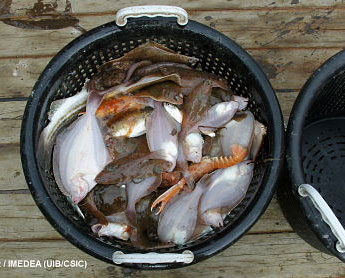|

Samples of the studied fish and crustacean in the analysis. (Photo: Hilmar Hinz)
Trawling modifies predator-prey relationships
 SPAIN
SPAIN
Friday, October 20, 2017, 22:20 (GMT + 9)
A group of scientists has been able to demonstrate how the elimination of competitors with similar diets, both of the same species as of others, and the decrease of their main prey (known effects of trawling but which have been studied separately so far) modify the diet of commercial species, ultimately affecting their body condition.
Body condition is used as an indicator of the amount of energy stored by an individual and can be considered a measure of the physical and biological events that have happened to a fish during some period of its life.
The importance of this study is that, to date, there have been few studies that directly and simultaneously analyze the response of the exploited species to the impacts of trawling intensity on the availability of their prey, the changes produced in their diet, the secondary consequences that these changes have on their body condition and how these responses modify the isotopic signal of muscle 13C and 15N.
The results of the study -- published in the journal Scientific Reports by researchers of the Mediterranean Institute of Advanced Studies (IMEDEA-UIB/CSIC), the Spanish Institute of Oceanography (IEO) and other European research centres -- have made it possible to test the direct and indirect effects of trawling on demersal species caused by two antagonistic effects related to the quality and quantity of feed available.
On the one hand, trawling causes the elimination of the total biomass of benthic consumers, increasing the net availability of the preys for the rest of the specimens. On the other hand, it induces a change in the composition and abundance of benthic preys through the physical impacts of fishing gear on the seabed. Depending on which of these effects is more dominant, the consequences of trawling in relation to the availability of preys, and therefore, their consumption, can be positive or negative, and may cause a better or worse body condition of the caught species.
The study was carried out in two areas of the North Atlantic, the Irish Sea and the Kattegat Strait subjected to different fishing intensities. The trawling intensities in Kattegat are lower and range from 0.2 to 7.8 trawls a year while in the Irish Sea the trawling intensities are higher, with intensities ranging from 2.7 to 11.9 trawls a year.
Two flat fish of the Pleuronectidae family were studied: plaice (Pleuronectes platessa) and yellowtail flounder (Limanda limanda); and Norway lobster (Nephrops norvegicus), a decapod crustacean of the Nephropidae family. The abundance and biomass of these species and their potential competitors were quantified by means of trawling gear while the abundance and biomass of the main preys were analyzed from sediment samples obtained by dredging.
In this way, it was possible to calculate the relationships between the proportion of biomass of consumers and preys that made it possible to determine if the availability of preys increased or decreased in relation to the different trawling intensity.
In addition, muscle samples from the three target species of the study were analyzed to determine the stable isotope levels of 13C and 15N. The analysis of these isotopes made it possible to detect changes in the diet of the species comparing the two zones according to the fishing intensity level.
Finally, the stomach contents of the two flatfish species were also analyzed. Thus, the composition of the diet of these species was analyzed by trophic groups as a function of the trawling intensity, taking into account also the specimens’ 13C muscle concentrations.
The results of the research show that trawling affects the biomass of consumers and preys differently in the two study areas.
In the Kattegat Strait, trawling mainly affected the biomass of benthic consumers, which reduced competition. On the other hand, in the Irish Sea, fishing intensity had a negative effect on benthic preys and led to a decrease in body condition.
The consequences of these differences in the impact of fishing also resulted in differences between annual trawling intensity and the isotopic signals of ?13C and ?15N, body condition and diet composition between the two study areas.
The conclusions of this study point out that trawling not only affects by catching fish and benthic species, but also modifying predator-prey relationships. In this way, the secondary effects of trawling should be taken into account in the implementation of the ecosystem approach.
Fisheries management measures, such as reduction or displacement of fishing effort through marine protected areas or temporary closures, may have unexpected effects on both benthic preys and their predators. These consequences should be carefully assessed and adapted to the local scenarios in each case to ensure the effectiveness of fisheries management measures.
The possibility of studying the effects of fishing in two zones under different intensity gradients has shown that the thresholds for detecting the impact of fishing vary according to the variables analyzed, the species considered and the areas of study.
For example, according to the results of this study, fishing frequencies of five trawls per year can improve the availability of feeding and the condition of individuals of plaice and Norway lobster in the Kattegat Strait. On the other hand, in the Irish Sea, the frequency of fishing should not exceed four trawls per year to avoid negative effects on the diet of Norway lobster and, therefore, its body condition.
editorial@seafood.media
www.seafood.media
|



